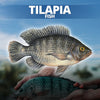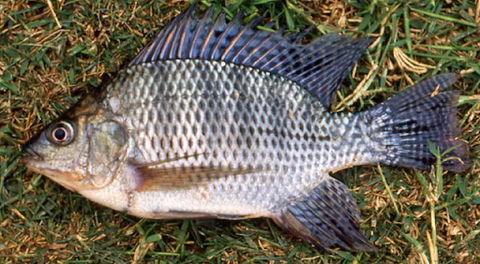
Tilapia, the freshwater fish, is the common name of the species from cichlid family tribes. The species belongs to coelotilapine, coptodonine, heterotilapine, oreochromine, pelmatolapiine, and tilapia tribes. Tilapia was also called Saint Peter's fish.

Tilapia fish is the second most farmed fish and fourth most consumed fish of the United States. Tilapia is known as the ‘king of sunfish.’
Physical Characteristics:
- The body shape is compressed, and they have deep bodies.
- The dorsal fin has dense spines from the front edge and is long.
- The anal fin and pelvis also have spines.
- The teeth of tilapia fish are conical.
- They show the division of labor between mandibles and pharyngeal jaws to process a variety of food items efficiently.

- The mouth is protrusible, and lower pharyngeal bones are modified into a tooth-like structure; it is the characteristic of the cichlid family.
- Vertical bars are present along the sides of fingerlings.
- They show different color patterns, each distinctive to species. As Mozambique tilapia has a yellow color, Nile tilapia has grayish pink color patterns. However, these color patterns also change depending upon food availability, environment, and sexual maturity.
Diet of Tilapia:
Tilapia are herbivores. Tilapia fish primarily feed on algae, duckweed, bacteria, detritus, and many other plants in their natural environment. In farms, they provided them with corn or soybean meal, and if nothing was available, they were given sheep manure.
Habitat and Range of Tilapia:
Tilapia is native to the Middle East and Africa and present in the southeastern side of America. Tilapia fish are common in warm waters. Tilapia are present in freshwater and brackish water.

Tilapia mainly inhabit slow-moving waters like ponds, rivers, canals, and lakes or shallow waters.
Reproduction:
Tilapia is known as a mouth-brooding species. This is because they carry their eggs in their mouths after hatching during the incubation period. Tilapia build the nest to guard their eggs.

The environment and food availability mainly control sexual maturity.
Tilapia Fishing:
When and Where:
The best time to catch tilapia is the spawning season. The two primary reasons for this are,
- Tilapia are territorial
- Tilapia are hungry and will attack everything.
The deep, shallow warm water is the best place as their spawning nests are there.
Tilapia Fishing Gear:
A true angler knows the importance that the right gear will change the catching game. As tilapia are tricky to catch as they are herbivores and will not take the bait, their impulsive and nervous nature is also a challenging feat.
- Bread balls are commonly used as bait by most anglers.
-
Lightweight tackle is appropriate as tilapia is small fish, the spinning fishing reel is the best choice.

Importance of Tilapia:
- Tilapia is very popular among chefs as it has a mild taste, is low in price, and can be easily prepared.

- Tilapia feed on the aquatic plants, so they are used as unwanted vegetation control; this practice reduces metal-based toxic chemicals.
- Tilapia are also detritus feeders, so they help to increase oxygen which is helpful for other fishes.
- Tilapia feed on mosquito larvae, and this helps to control malaria.
- Tilapia skin is also used to treat burn skin and is also used as a bandage in Brazil.





